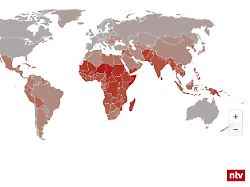World map on the CO2 debate
How the climate blame is distributed
By Martin Morcinek and Sebastian Schneider
12/30/2022, 8:11 p.m
The effects of climate change hit poorer countries earlier and harder than the large industrial nations. The vast majority of greenhouse gases do not come from emerging and developing countries. The most important polluter countries are in the northern hemisphere. A look at the world map of climate debt.
The COP 27 UN climate conference in the Egyptian seaside resort of Sharm El Sheikh is about a huge sum: billions in compensation payments are intended to help countries particularly affected by climate change to cushion the acute consequences of global warming. The countries that have emitted the most greenhouse gases should pay for the damage and adjustments. As with an action for damages in court, the polluter pays principle applies in the negotiations.
Where do most greenhouse gases come from? The ntv.de world map of CO2 emissions shows which countries bear the greatest responsibility for climate change:
The map does not show the full spectrum of the different greenhouse gases. Only the contributions of the countries to the worldwide emissions of carbon dioxide (CO2), which are typically produced in large quantities as exhaust gas when coal, oil or natural gas are burned, are shown here. The rough distribution of responsibility is already clear. The bulk of the exhaust gases continue to come from countries such as the USA, China and the states of Europe.
“We are currently experiencing a global rise in temperature at an unprecedented rate,” says the United Nations World Climate Report. Alongside methane, carbon dioxide is considered to be the most important driver of climate change. Both gases are released when fossil fuels are used to generate electricity, for heating and in transport. According to the UN, the ten largest greenhouse gas emitters recently accounted for more than two-thirds of global CO2 emissions.
The problem: Developing and emerging countries are usually affected earlier and more severely by the direct effects of climate change than those countries that are currently still blowing the most CO2 into the atmosphere. Even if green technologies should soon find their way into the rich countries and emissions should fall, the global exhaust gas load is likely to continue to rise: coal, oil and natural gas are currently still the cheapest energy sources for up-and-coming emerging countries.
Who should pay for the switch to low-emission energy solutions? States like Niger, Sudan or Afghanistan have neither the know-how nor the financial reserves to adapt to rapidly changing environmental conditions. Money from rich countries, according to the idea behind climate compensation payments, could help to support the economy and society in threatened countries in their transformation.
